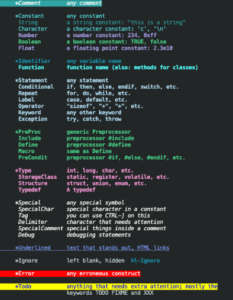Vim, the versatile and powerful text editor, is favored by many developers and programmers. One way to enhance your Vim experience is by creating custom color themes. Custom Vim color themes not only reflect your personal style but also improve code readability and reduce eye strain during long coding sessions. In this step-by-step guide, we will walk you through the process of Creating Custom Vim Color Themes.
Understanding Vim Color Schemes
Before diving into the customization process, it’s essential to grasp the concept of Vim color schemes. A color scheme is a predefined set of colors that Vim uses to highlight various syntax elements within your code. Vim comes with several built-in color schemes, but creating your own allows you to tailor the editor’s appearance to your liking.
Selecting Your Base Color Scheme
To start creating your custom Vim color theme, choose a base color scheme as your foundation. You can select from Vim’s default schemes or explore various third-party options available online. Pick a base scheme that aligns with your preferences regarding color balance and overall aesthetic.
Creating the Colorscheme File
In Vim, color schemes are defined in .vim files, usually with a .vim extension. To create your custom color scheme, you’ll need to create a new .vim file with a unique name. Therefore, you can do this by opening your terminal and navigating to your Vim configuration folder, often located at ~/.vim/colors. Use the touch command to create a new .vim file, like so:
touch ~/.vim/colors/my_custom_theme.vim
Editing the Colorscheme
Now that you have your colorscheme file in place, it’s time to start defining your color palette. Open the file in Vim or your preferred text editor. Within the file, Vim uses a specific syntax to specify colors for different syntax elements.
Begin by setting the background color:
hi Normal guibg=#000000 ctermbg=0
In the above example, we’ve set the background color to black. You can replace #000000 with your desired background color code. Next, you can define colors for specific syntax elements such as comments, keywords, and strings using similar syntax.
Customizing Syntax Highlighting
Customizing the syntax highlighting for various elements is the heart of creating a unique Vim color theme. Vim provides a wide range of syntax groups you can modify, such as Comment, String, Function, Keyword, and many more. Therefore, to change the color for a specific syntax group, use the hi (highlight) command followed by the group name and color definition.
Here’s an example of changing the color for comments:
hi Comment guifg=#808080 ctermfg=8
In this case, we’ve set the color for comments to a shade of gray. Hence, customize each syntax group to your liking, experimenting with different colors to achieve the desired visual effect.
Testing Your Custom Vim Color Theme
After defining all your color settings in the colorscheme file, it’s crucial to test your theme in Vim to ensure it looks as expected. Moreover, to do this, add the following line at the end of your colorscheme file:
colorscheme my_custom_theme
Replace my_custom_theme with the name of your theme file, excluding the .vim extension.
Save your changes and exit the text editor. Then, open a new terminal window and launch Vim to see your custom color theme in action:
vim
If everything looks good, congratulations! You’ve successfully created your custom Vim color theme.
Installing Your Custom Theme
To make your custom theme accessible in Vim, you need to place the colorscheme file in the correct directory. Move your .vim file to the ~/.vim/colors directory:
mv ~/.vim/colors/my_custom_theme.vim ~/.vim/colors/
Once the file is in the right location, you can activate your custom theme anytime by adding the following line to your Vim configuration file (usually located at ~/.vimrc):
colorscheme my_custom_theme
Conclusion
In conclusion, customizing your Vim color theme is a fantastic way to personalize your coding environment and make it more visually appealing. With this step-by-step guide, you’ve learned how to select a base color scheme, create a colorscheme file, customize syntax highlighting, and test your theme. Now, you can enjoy coding in Vim with a theme that reflects your unique style.
Incorporating a custom Vim color theme enhances both the aesthetics and functionality of your text editor, making coding a more enjoyable and efficient experience. So, go ahead and unleash your creativity by crafting a Vim color theme that suits your taste and preferences. Your coding environment has never looked better!


